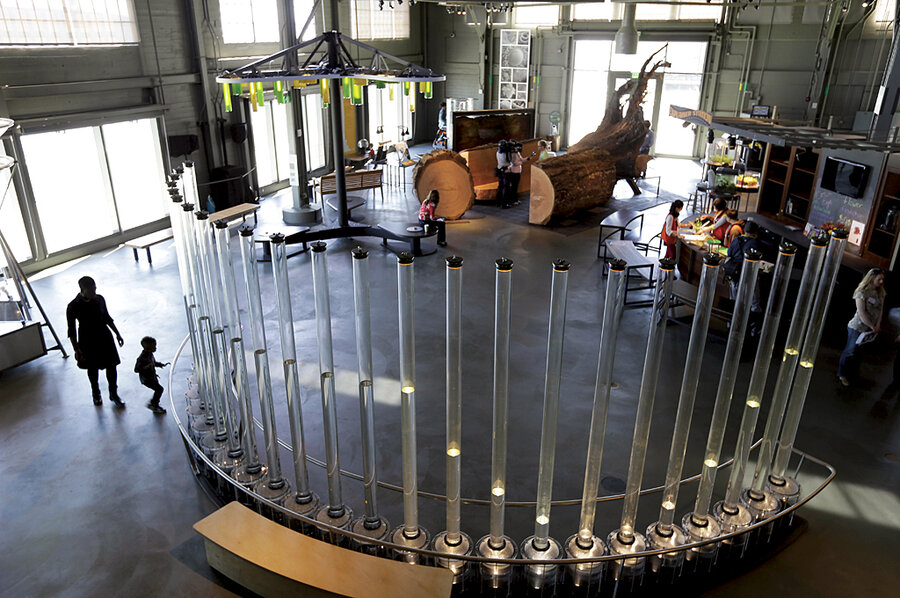Charities latch onto 'crowdsourcing'
Loading...
| San Francisco
With donations growing slowly, if at all, US charities are pulling out a new tool to help fill their coffers: a mass appeal that might ask you for only $5.
Instead of looking for a few large donors, they're finding that acquiring many small ones is an effective way to battle homelessness, poverty, hunger, and so on. Instead of narrow appeals tied to specific events or drives – as has long been done for charity walks and races – philanthropic groups are using the power of the Internet to expand their fundraising to a mass audience at a much lower cost than traditional methods.
The result: a small-donation bonanza that is capturing the largest chunk of the crowdsourcing market.
When the Exploratorium, a San Francisco technology museum catering to young people, wanted to install a series of public interactive exhibits called "Living Innovation," the organization's budget was tapped out. So Bonnie Loyd, the museum's director of institutional support, turned to an online service called Indiegogo to raise funds. The effort raised $32,700.
"It gives us a whole new way to raise money and to reach a younger audience," she says.
Indiegogo and rival Kickstarter are much better known for raising funds for would-be entrepreneurs and filmmakers through mass appeals to small-time investors. Such "crowdfunding" campaigns, as they are known, typically include a video message and an appeal for support, often in the amount of $5, $10, or $25. Now, large nonprofits are using crowdfunding services to raise charitable contributions.
"This is really about creating a retail model of philanthropy," says Breanna DiGiammarino, education vertical director for San Francisco-based Indie-gogo. "People give to people. Building that connection is really important for success."
The Boston Philharmonic Youth Orchestra, for example, held a Kickstarter campaign to raise more than $45,000 to help support its trip to the Netherlands in June. The program takes promising young musicians between the ages of 12 and 21 on a 13-day tour of school music programs and performances.
Disaster relief is also a common appeal. After superstorm Sandy, the nonprofit Architecture for Humanity launched a recovery campaign on Indie-gogo. The project, "Restore the Shore," was targeted at Seaside Heights, N.J., one of many communities that suffered significant damage from the storm. That effort raised more than $1 million.
Social causes represent the largest chunk of the emerging crowdfunding campaigns, about 30 percent of the appeals, according to a research report from Los Angeles-based Massolution, which tracks crowdfunding. It estimates the overall crowdfunding space could reach $5 billion this year.
The new strategy comes as charities are struggling to boost donations. According to the Chronicle of Philanthropy, an industry publication, giving is expected to be flat in 2014 after rising only slightly in 2013, which means nonprofits will be competing fiercely for donor dollars. Every tool helps.
"It's a quick and cost-effective way to reach a wide array of people," says Nate Drouin, chief executive of Boston-based Fundraise.com, which helps charities build online fundraising campaigns. "It's really low-risk to try different campaigns to see what works," he adds.
In some ways, appealing to small donors has been around for years. Look no further than a marathon pledge or public radio donation drive. But the costs are dramatically less with crowdfunding, and crowdfunding gives charities a way to enhance their fundraising, charity experts say. Most crowdfunding services take between 4 and 10 percent of each donation.
"We're seeing such tremendous growth in crowdfunding because nonprofits really see it as a tool that levels the playing field. Donors at all giving levels can participate no matter what the project might be," says Bruce DeBoskey, a Colorado-based philanthropic strategist.
Nonprofits are using crowdfunding to make appeals for smaller projects that would-be donors can relate to. And they're using clever perks to incentivize donations. The Exploratorium offered ring tones and sketches of its planned exhibit while Restore the Shore gave away music downloads. Perks are often donated to the charity, making the cost minimal.
For the Exploratorium, a key benefit was engaging with a younger audience that could yield lifelong patrons. "Our board [of directors] and staff executives were really intrigued by the success of the Obama campaign and how they used crowdfunding and encouraged us to use it," says the museum's Ms. Loyd.
Others, such as DonorsChoose, Kiva, and Watsi are taking a different approach and letting donors give directly to those in need.
Watsi, a San Francisco-based charity, uses crowdfunding to help patients in Africa, South America, and Southeast Asia receive medical care. Medical professionals affiliated with Watsi encourage needy patients to make their case to Watsi donors. According to Chase Adams, the organization's chief executive officer, the charity has raised $2 million in the past year.
Be wary of claims of philanthropies, and research an organization before giving money to it, warns Mr. DeBoskey, the philanthropic expert. "As with everything, the vast majority are going to do what they say, but there are always a few that will commit fraud."
He encourages donors to use charity evaluators like Charity Navigator and GuideStar to learn more about a nonprofit.








